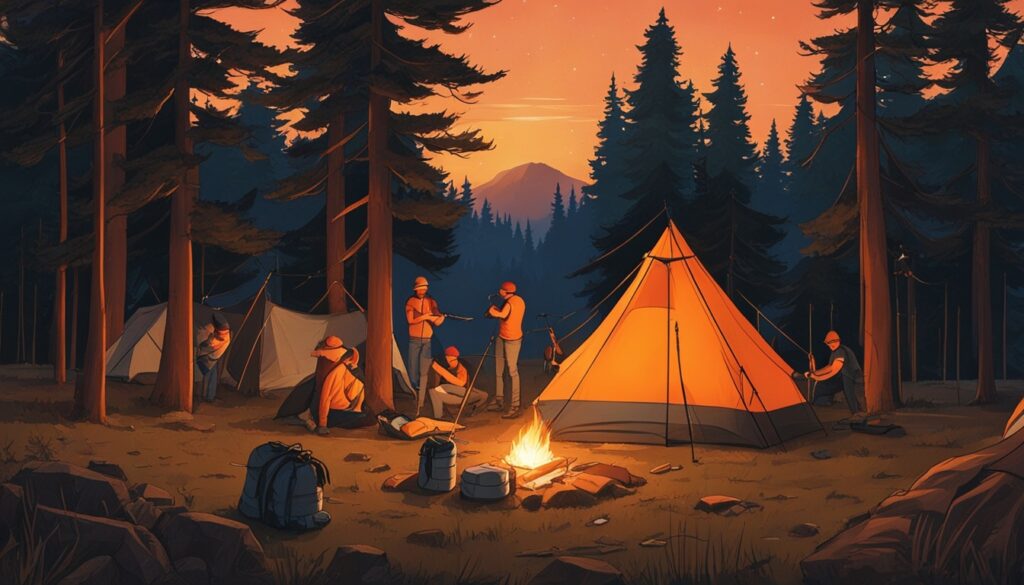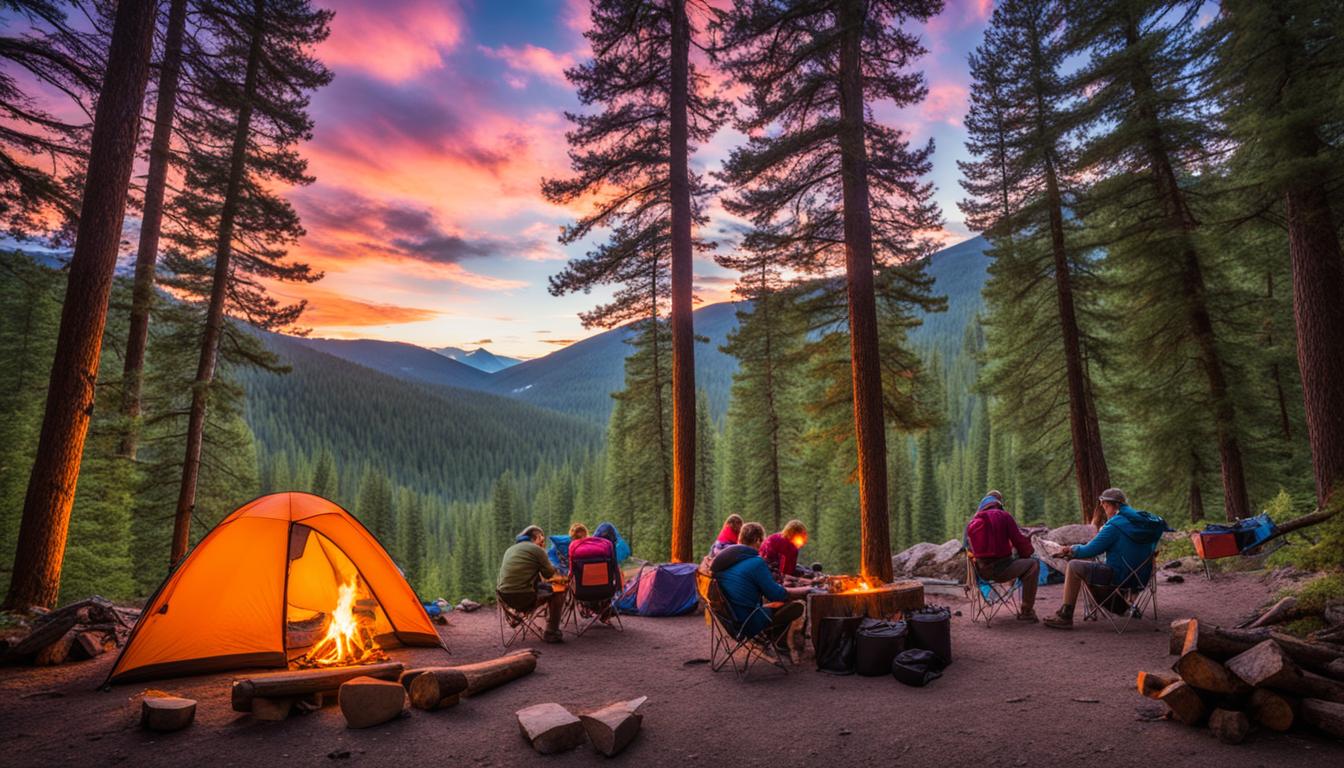Going on a camping trip in the wilderness needs careful planning. You must know how to set up your campsite safely and enjoyably. This guide will teach you everything you need to know to make your outdoor home perfect.
Key Takeaways
- Thoroughly research legal and accessible campsites to ensure a safe and lawful camping experience.
- Consider environmental conditions such as weather, terrain, and wildlife to choose the ideal campsite location.
- Practice the principles of Leave No Trace to minimize your impact on the natural environment.
- Adopt a minimalist approach to camping gear to lighten your load and embrace the simplicity of the wilderness.
- Properly set up your tent and sleeping systems to ensure a comfortable and restful night’s sleep.
Planning Your Wilderness Camping Trip
Going on a wilderness camping trip needs careful planning for safety and fun. First, check if the campsites you want to use are legal and easy to get to. Learn about wilderness camping permits and regulations in the area. Also, know about environmental conditions that might change your trip.
Researching Legal and Accessible Campsites
Start by seeing if the area lets you camp in the wild. Some places need permits or reservations. Make sure you get these early. Also, check that the campsite is safe to get to with your stuff.
Considering Environmental Conditions
- Look into the temperature and precipitation in the area to pack right.
- Learn about the wildlife and how they act, to stay safe with them.
- Think about the terrain, height, and dangers of nature that might affect your trip.
By doing your homework on campsites and environmental conditions, you’re ready for a safe and fun camping trip. This helps make your adventure in nature better and safer.
“The journey of a thousand miles begins with a single step.” – Lao Tzu
Choosing the Ideal Campsite Location
When picking the best spot for camping, think about a few key things. The spot should keep you safe from the weather and follow “leave no trace” camping. This means you don’t harm the environment.
Protection from the Elements
Find a spot that’s flat and hard. It should also protect you from wind, rain, and other bad weather. Stay away from places that flood or have trees that might fall.
Try to camp at least 200 feet from water to help protect nature. This keeps your impact small.
Leave No Trace Principles
- Choose a campsite that has been used before, rather than clearing a new area.
- Leave the site as you found it, without altering the natural landscape.
- Dispose of all waste properly, following the principles of “leave no trace” camping.
By picking your campsite wisely and following “leave no trace,” you can enjoy nature. You’ll also protect the environment and keep nature’s balance.
“The best thing one can do when it’s raining is to let it rain.” – Henry Wadsworth Longfellow
| Campsite Considerations | Ideal Conditions |
|---|---|
| Terrain | Flat, hard surface |
| Weather Protection | Natural shelter from wind, rain |
| Water Sources | At least 200 feet away |
| Environmental Impact | Minimal, following “leave no trace” principles |
Minimalist Camping: Less is More
When you go minimalist camping, it’s all about “less is more”. Bring only the essential wilderness gear to make your backpack lighter. This also helps you have a smaller environmental impact. Don’t take things you don’t need. Focus on what you must have for survival, comfort, and safety. This way, you move easily through nature and don’t disturb it much.
Choosing the right gear is key in lightweight backpacking. Find multi-purpose items like a sleeping bag that can also be a blanket. Pick compact and lightweight versions of things like tents, stoves, and water filters. This way, you carry less but still have what you need.
- Prioritize minimalist camping and pack only the necessities
- Choose compact and lightweight gear to reduce the weight of your backpack
- Look for multi-purpose items that serve multiple functions
- Minimize your environmental impact by reducing your campsite footprint
| Gear Item | Minimalist Camping Recommendation | Weight Comparison |
|---|---|---|
| Tent | Ultralight, 1-2 person tent | 3-4 lbs vs. 6-8 lbs for a standard 4-person tent |
| Sleeping Bag | Compact, temperature-rated sleeping bag | 2-3 lbs vs. 4-6 lbs for a standard sleeping bag |
| Cooking System | Lightweight, compact stove and cookset | 1-2 lbs vs. 3-4 lbs for a full-size camp kitchen |
Embracing minimalist camping lets you enjoy nature with a lighter load and less impact. With good planning and the right gear, you can start your backpacking trip with confidence and ease.
Setting up a wilderness campsite
Once you’ve found the perfect spot for your campsite, it’s time to set up. You need to pitch your tent and arrange your sleep gear right. This makes sure you’re comfortable and safe in the wild.
Tent Pitching: Shelter from the Elements
Picking the right tent is key for your campsite. Choose one that fits the weather and your group size. Make sure it’s set up tight against wind and rain.
Follow the tent’s setup guide closely. Use good anchoring to keep it steady.
Sleeping Systems: Comfort and Warmth
Your sleep gear, like your sleeping bag and pad, is very important. Get a sleeping bag that’s made for the area’s temperatures. Add a comfy, insulating pad for warmth and rest.
“Proper sleep is essential for a successful wilderness camping trip. Investing in a high-quality sleeping system can make all the difference in your comfort and enjoyment.”
By using these tips, you can make a cozy and safe campsite. You’ll sleep well and be ready for the next day’s adventures.

Managing Campfires Responsibly
Wilderness camping and wilderness campfires are a perfect pair. But, building and keeping campfires in nature needs a lot of care. As you start your adventure, make sure to focus on fire safety. Follow the rules of leave no trace fire management.
Before you light any fire, check if it’s okay to have wilderness campfires where you plan to camp. Rules and nature can change, so knowing the rules is key. This helps you follow any rules and protect nature.
- If fires are okay, pick a spot with a fire pit or little plants to keep it from getting out of control.
- Keep the fire small and safe, using only dead wood from the area.
- Make sure the fire is fully out before you leave, so you don’t leave any signs behind.
“Responsible wilderness campfire management is not only a matter of safety, but also a crucial aspect of preserving the natural beauty and integrity of the wilderness.”
By doing these things and focusing on fire safety and leave no trace fire management, you can enjoy a campfire. This way, you won’t harm the wilderness too much. Your careful actions can help keep nature beautiful for everyone.
Respecting Wildlife and Natural Habitats
When you go camping in the wilderness, it’s key to respect the animals and their homes. Don’t get too close to animals or bother them. This can cause problems.
The paths and places where you camp might be where animals live or rest. So, think about how you’re affecting them. Try to leave as little mark as possible. By following “leave no trace,” you help keep the environment safe.
- Observe wildlife from a safe distance and never approach or feed them.
- Stick to established trails and campsites to avoid trampling sensitive areas.
- Avoid disturbing or damaging natural habitats, such as nesting sites or dens.
- Properly dispose of all waste, including food scraps, to prevent attracting wildlife to your campsite.
- Choose a campsite that is already established and avoid creating new ones.
Respecting wildlife and natural habitats while camping helps protect these areas. Your efforts to minimize your impact make your trip better and help protect the wild places you visit.
| Best Practices for Respecting Wildlife | Potential Consequences of Disrupting Wildlife |
|---|---|
| Observe animals from a safe distance | Stress, disruption of natural behaviors, and potential conflicts |
| Avoid feeding wildlife | Dependency on human food, increased risk of human-wildlife conflicts |
| Stick to established trails and campsites | Damage to sensitive habitats, disruption of animal movement and breeding patterns |
| Properly dispose of all waste | Attracting wildlife to campsites, leading to dangerous situations |
By focusing on respecting wildlife and minimizing impact on natural habitats while camping, you help protect these areas for the future.

“The true conservationist is a man who knows that the world is not given by his fathers, but borrowed from his children.” – John James Audubon
Maintaining Cleanliness and Sanitation
Keeping the outdoors clean is key for nature and our health. By following leave no trace, we can enjoy nature without harming it. This way, we protect both campers and wildlife.
Proper Waste Disposal
Proper waste disposal is vital in camping. Always take your trash with you and know how to handle human waste. Dig toilets at least 200 feet from water to keep the environment safe.
- Pack out all trash and waste, leaving no trace behind
- Dig catholes at least 200 feet away from water sources for human waste disposal
- Avoid contaminating water sources or the natural environment
- Follow the leave no trace principles to minimize your impact
By keeping camping clean, we protect nature for the future. The wilderness is ours to care for. Let’s do our part to keep it beautiful.
“Take nothing but memories, leave nothing but footprints.” – Chief Seattle
Essential Gear for Wilderness Camping
Choosing the right gear is key for a great wilderness camping trip. You need everything from backpacks to tents and sleeping gear. Each item is important for a safe and fun time outside.
Backpacks and Tents
Pick a strong backpack that holds all your stuff and feels good to carry. Think about size, how it fits, and how long it lasts. Also, get a tent that can handle the weather in the wild. Make sure it’s right for the season and where you’re camping.
Sleeping Bags and Pads
Getting a good night’s sleep helps you recover after a busy day. Choose a sleeping bag that’s warm enough for the weather. Then, add a sleeping pad for extra comfort and to keep you warm.
FAQ
What are the essential steps for planning a successful wilderness camping trip?
How do I choose the ideal location for my wilderness campsite?
What is the “less is more” approach to wilderness camping?
How do I properly set up a tent and sleep system in the wilderness?
What are the guidelines for managing campfires responsibly in the wilderness?
How can I respect the local wildlife and natural habitats while camping in the wilderness?
What are the best practices for maintaining cleanliness and proper waste disposal in the wilderness?
What are the essential pieces of gear I should consider for a wilderness camping trip?
Source Links
- A Beginner’s Guide to Camping in the Wilderness – https://www.outdoorlife.com/adventure/camping-in-the-wilderness/
- The Do’s & Don’ts of Wilderness Camping | Lost & Curious – https://lostandcurious.com/tutorials/the-dos-donts-of-wilderness-camping/
- Backpacking for Beginners: Must-Know Tips for Wilderness Camping – https://www.reneeroaming.com/backpacking-for-beginners/
